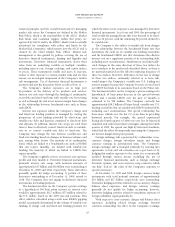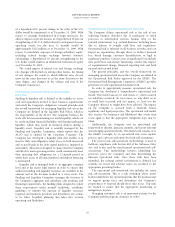American Express 2009 Annual Report Download - page 50
Download and view the complete annual report
Please find page 50 of the 2009 American Express annual report below. You can navigate through the pages in the report by either clicking on the pages listed below, or by using the keyword search tool below to find specific information within the annual report.2009 FINANCIAL REVIEW
AMERICAN EXPRESS COMPANY
General principles and the overall framework for managing
market risk across the Company are defined in the Market
Risk Policy, which is the responsibility of the ALCO. Market
Risk limits and escalation triggers within that policy are
approved by ALCO and by the ERMC. Market risk is centrally
monitored for compliance with policy and limits by the
Market Risk Committee, which reports into the ALCO and is
chaired by the Chief Market Risk Officer. Market risk
management is also guided by policies covering the use of
derivative financial instruments, funding and liquidity and
investments. Derivative financial instruments derive their
value from an underlying variable or multiple variables,
including interest rate, foreign exchange, and equity indices
or prices. These instruments enable end users to increase,
reduce or alter exposure to various market risks and, for that
reason, are an integral component of the Company’s market
risk management. Use of derivative financial instruments is
incorporated into the discussion below as well as Note 12.
The Company’s market exposures are in large part
by-products of the delivery of its products and services.
Interest rate risk arises through the funding of cardmember
receivables and fixed-rate loans with variable-rate borrowings
as well as through the risk to net interest margin from changes
in the relationship between benchmark rates such as Prime
and LIBOR.
Interest rate exposure within the Company’s charge card
and fixed-rate lending products is managed by varying the
proportion of total funding provided by short-term and
variable-rate debt and deposits compared to fixed-rate debt
and deposits. In addition, interest rate swaps are used from
time to time to effectively convert fixed-rate debt to variable-
rate or to convert variable-rate debt to fixed-rate. The
Company may change the mix between variable-rate and
fixed-rate funding based on changes in business volumes and
mix, among other factors. The majority of its cardmember
loans, which are linked to a benchmark rate such as PRIME
that can reprice monthly, are funded with variable-rate
funding, the majority of which are linked to LIBOR that
reprice monthly.
The Company regularly reviews its interest rate exposure
profile and may modify it. Derivative financial instruments,
primarily interest rate swaps, with notional amounts of
approximately $17 billion and $18 billion were outstanding at
December 31, 2009 and 2008, respectively. These derivatives
generally qualify for hedge accounting. A portion of these
derivatives outstanding as of December 31, 2009, extend to
2018. The Company does not engage in derivative financial
instruments for trading purposes.
The detrimental effect on the Company’s pretax earnings
of a hypothetical 100 basis point increase in interest rates
would be approximately $117 million ($75 million related to
the U.S. dollar), based on the 2009 year-end positions. This
effect, which is calculated using a static asset liability gapping
model, is primarily determined by the volume of variable-rate
funding of charge card and fixed-rate lending products for
which the interest rate exposure is not managed by derivative
financial instruments. As of year end 2009, the percentage of
total worldwide managed loans that were deemed to be fixed-
rate was 34 percent, with the remaining 66 percent deemed to
be variable rate.
The Company is also subject to market risk from changes
in the relationship between the benchmark Prime rate that
determines the yield on its variable-rate lending receivables
and the benchmark LIBOR rate that determines the effective
interest cost on a significant portion of its outstanding debt,
including asset securitizations. Simultaneous and identically-
sized changes in the same direction of these two indices do
not contribute to the market risk described above, as there is
no material mismatch in the effective repricing frequency of
these two indices. However, differences in the rate of change
of these two indices, commonly referred to as basis risk,
would impact the Company’s variable-rate U.S. lending net
interest margins because the Company borrows at rates based
on LIBOR but lends to its customers based on the Prime rate.
The detrimental effect on the Company’s pretax earnings of a
hypothetical 10 basis point decrease in the spread between
Prime and 1 month LIBOR over the next 12 months is
estimated to be $38 million. The Company currently has
approximately $38.2 billion of Prime-based, variable-rate U.S.
lending receivables that are funded with LIBOR-indexed debt,
including asset securitizations. The spread relationship has
been more volatile over the last 2
1
⁄
2
years than in preceding
historical periods. For example, the spread experienced
during the fourth quarter of 2008 was very low by historical
standards and reduced net interest margins; during the fourth
quarter of 2009, the spread was high by historical standards,
which had the effect of temporarily increasing the Company’s
net interest margin from prior periods.
Foreign exchange risk is generated by cardmember cross-
currency charges, foreign subsidiary equity and foreign
currency earnings in international units. The Company’s
foreign exchange risk is managed primarily by entering into
agreements to buy and sell currencies on a spot basis or by
hedging this market exposure to the extent it is economically
justified through various means, including the use of
derivative financial instruments such as foreign exchange
forwards, options, and cross-currency swap contracts, which
can help “lock in” the value of the Company’s exposure to
specific currencies.
At December 31, 2009 and 2008, foreign currency hedge
instruments with total notional amounts of approximately
$19 billion and $17 billion, respectively, were outstanding.
Derivative hedging activities related to cross-currency charges,
balance sheet exposures, and foreign currency earnings
generally do not qualify for hedge accounting; however,
derivative hedging activities related to translation exposure of
foreign subsidiary equity generally do.
With respect to cross-currency charges and balance sheet
exposures, including related foreign exchange forward
contracts outstanding, the effect on the Company’s earnings
48
























